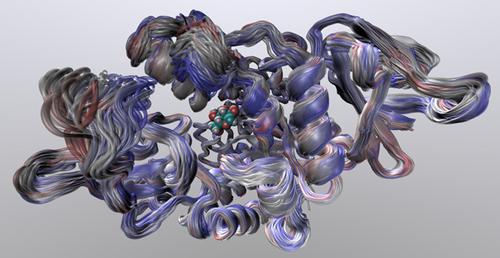当前位置:
X-MOL 学术
›
WIREs Comput. Mol. Sci.
›
论文详情
Our official English website, www.x-mol.net, welcomes your
feedback! (Note: you will need to create a separate account there.)
Biomolecular simulations: From dynamics and mechanisms to computational assays of biological activity
Wiley Interdisciplinary Reviews: Computational Molecular Science ( IF 16.8 ) Pub Date : 2018-09-27 , DOI: 10.1002/wcms.1393 David J. Huggins 1, 2, 3 , Philip C. Biggin 4 , Marc A. Dämgen 4 , Jonathan W. Essex 5, 6 , Sarah A. Harris 7, 8 , Richard H. Henchman 9, 10 , Syma Khalid 5, 6 , Antonija Kuzmanic 11 , Charles A. Laughton 12, 13 , Julien Michel 14 , Adrian J. Mulholland 15 , Edina Rosta 16 , Mark S. P. Sansom 4 , Marc W. van der Kamp 15, 17
Wiley Interdisciplinary Reviews: Computational Molecular Science ( IF 16.8 ) Pub Date : 2018-09-27 , DOI: 10.1002/wcms.1393 David J. Huggins 1, 2, 3 , Philip C. Biggin 4 , Marc A. Dämgen 4 , Jonathan W. Essex 5, 6 , Sarah A. Harris 7, 8 , Richard H. Henchman 9, 10 , Syma Khalid 5, 6 , Antonija Kuzmanic 11 , Charles A. Laughton 12, 13 , Julien Michel 14 , Adrian J. Mulholland 15 , Edina Rosta 16 , Mark S. P. Sansom 4 , Marc W. van der Kamp 15, 17
Affiliation

|
Biomolecular simulation is increasingly central to understanding and designing biological molecules and their interactions. Detailed, physics‐based simulation methods are demonstrating rapidly growing impact in areas as diverse as biocatalysis, drug delivery, biomaterials, biotechnology, and drug design. Simulations offer the potential of uniquely detailed, atomic‐level insight into mechanisms, dynamics, and processes, as well as increasingly accurate predictions of molecular properties. Simulations can now be used as computational assays of biological activity, for example, in predictions of drug resistance. Methodological and algorithmic developments, combined with advances in computational hardware, are transforming the scope and range of calculations. Different types of methods are required for different types of problem. Accurate methods and extensive simulations promise quantitative comparison with experiments across biochemistry. Atomistic simulations can now access experimentally relevant timescales for large systems, leading to a fertile interplay of experiment and theory and offering unprecedented opportunities for validating and developing models. Coarse‐grained methods allow studies on larger length‐ and timescales, and theoretical developments are bringing electronic structure calculations into new regimes. Multiscale methods are another key focus for development, combining different levels of theory to increase accuracy, aiming to connect chemical and molecular changes to macroscopic observables. In this review, we outline biomolecular simulation methods and highlight examples of its application to investigate questions in biology.
中文翻译:

生物分子模拟:从动力学和机理到生物活性的计算分析
生物分子模拟对于理解和设计生物分子及其相互作用越来越重要。基于物理的详细模拟方法正在证明在诸如生物催化,药物输送,生物材料,生物技术和药物设计等领域迅速增长的影响。模拟提供了对机理,动力学和过程进行独特详细的原子级洞察的潜力,以及对分子性质的日益准确的预测。模拟现在可以用作生物活性的计算分析,例如,在耐药性预测中。方法论和算法的发展,以及计算硬件的进步,正在改变计算的范围和范围。对于不同类型的问题,需要使用不同类型的方法。准确的方法和广泛的模拟有望与整个生物化学实验进行定量比较。原子模拟现在可以访问大型系统的实验相关时间尺度,从而导致实验和理论的丰富互动,并为验证和开发模型提供了前所未有的机会。粗粒度方法允许对更大的长度和时间范围进行研究,并且理论发展将电子结构计算带入了新的机制。多尺度方法是发展的另一个主要重点,它结合了不同层次的理论以提高准确性,旨在将化学和分子变化与宏观可观测物联系起来。在这篇综述中,我们概述了生物分子模拟方法,并重点介绍了其在生物学问题研究中的应用实例。
更新日期:2018-09-27
中文翻译:

生物分子模拟:从动力学和机理到生物活性的计算分析
生物分子模拟对于理解和设计生物分子及其相互作用越来越重要。基于物理的详细模拟方法正在证明在诸如生物催化,药物输送,生物材料,生物技术和药物设计等领域迅速增长的影响。模拟提供了对机理,动力学和过程进行独特详细的原子级洞察的潜力,以及对分子性质的日益准确的预测。模拟现在可以用作生物活性的计算分析,例如,在耐药性预测中。方法论和算法的发展,以及计算硬件的进步,正在改变计算的范围和范围。对于不同类型的问题,需要使用不同类型的方法。准确的方法和广泛的模拟有望与整个生物化学实验进行定量比较。原子模拟现在可以访问大型系统的实验相关时间尺度,从而导致实验和理论的丰富互动,并为验证和开发模型提供了前所未有的机会。粗粒度方法允许对更大的长度和时间范围进行研究,并且理论发展将电子结构计算带入了新的机制。多尺度方法是发展的另一个主要重点,它结合了不同层次的理论以提高准确性,旨在将化学和分子变化与宏观可观测物联系起来。在这篇综述中,我们概述了生物分子模拟方法,并重点介绍了其在生物学问题研究中的应用实例。











































 京公网安备 11010802027423号
京公网安备 11010802027423号